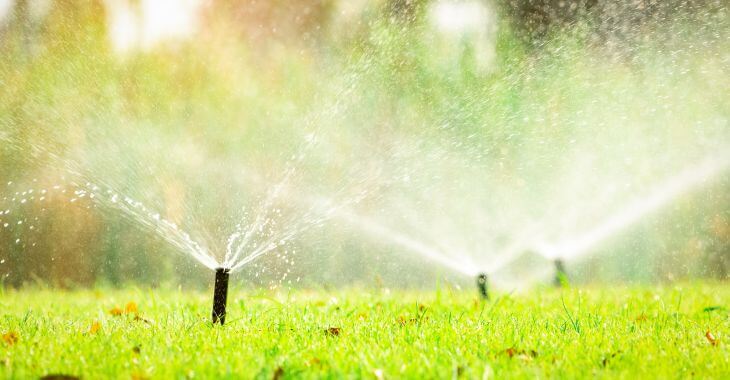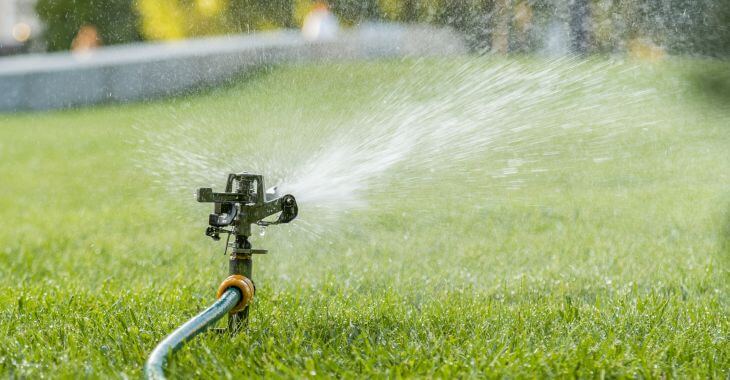How to Blow Out Sprinklers

There are times when you need to completely drain your irrigation system, most commonly for winter. Any water pipes that are above the frost line can freeze when temperatures drop – if there is any water left in your sprinkler pipes, they can freeze and burst. To prevent unnecessary damage to your sprinkler system, it is important to winterize your sprinklers by draining all the water from your pipes. Here is how to blow out sprinklers to winterize your irrigation system.
What Is a Sprinkler Blow Out?
Before it freezes, it is important to drain all the water from your irrigation system. While you can manually drain your sprinkler system or use an auto-drain method, the most efficient and effective option is a sprinkler blow out. This method can be used on almost all types of irrigation systems and is the method used by most professionals. The idea is to drain all the pipes and components of the sprinkler system of water, then clear any residual water with compressed air before shutting down the system for the winter.
Most landscapers that offer sprinkler installations or repairs can perform a sprinkler blow out for you and save you the time and trouble. However, if you are planning on winterizing your irrigation system using the blow out method yourself, you will need some tools and equipment. You should have pliers, goggles and a heavy-duty air compressor to complete the job. You will also want your sprinkler system manual to help you locate the different components of your system.
Draining Your Irrigation System
Before you can perform a sprinkler blow out, you need to drain your irrigation system of all water. This can be done manually or using an auto-drain valve system. You need to turn off the water flowing to your sprinkler system, then drain all the water from the system before you use compressed air to blow out any leftover water. To drain your irrigation system, follow these steps:
- Turn off your main water valve. Near your water meter or by the main water inlet should be the main water valve. Turn this completely off. If your sprinkler system uses a manual drain system, you will want to also turn off the backflow preventer if you have one on your water system.
- For auto-drain systems, you will still need to drain the valves. Locate the solenoid on each valve and loosen the cap to allow the valves to drain.
- For manual drain systems, turn off the mainline shut-off valve. You can then open one of the control valves to release the pressure – it may be on your controller, or you may need to do it manually. Finally, wearing goggles, open the valve at the lowest point on your mainline. If there is still pressure, the water may spray when you open the valve. Let all the water drain, then close the valve. Do this for every manual valve on the system’s mainline.
- Open all remaining valves after the mainline valves are completely drained. Some systems may have a boiler drain or stop and water valve – open this valve cap to drain any water from this pipe.
In some cases, draining your irrigation system can be enough to prevent freezing damage if all the water exits the pipes. However, if any water is trapped inside the pipes, it can freeze and cause expensive damage. The final step of sprinkler winterization is using compressed air to remove any water in the system.

Final Step: How to Blow Out Sprinklers
This step is tricky and requires the right air compressor. Most household air compressors cannot perform this level of volume and pressure. You may need to rent a compressor that can perform 20-50 CFM (cubit feet per meter) at less than 50 PSI for at least two minutes to blow out the water in each zone. The CFM can differ depending on the size and gallons-per-minute for the sprinkler heads in each zone. To blow out the sprinklers, follow these steps:
- Close all backflow prevention isolator valves and make sure all valves are open in the zone you are clearing.
- Connect the air hose to the blowout port and start with the zone furthest away from the compressor hookup.
- Turn on compressor and blow out lines until no water is coming out of the sprinklers – do this in all the zones.
As you can see, it can be more complex to winterize your irrigation system with a sprinkler blowout than most people think. If done incorrectly, a blowout can damage components in your sprinkler system. It is worth the investment to consider having a professional landscaper who offers irrigation maintenance services perform your sprinkler draining and blowout to ensure it is done correctly.